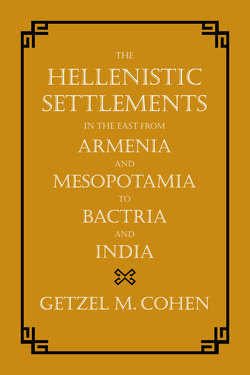Читать книгу The Hellenistic Settlements in the East from Armenia and Mesopotamia to Bactria and India - Getzel M. Cohen - Страница 10
На сайте Литреса книга снята с продажи.
ОглавлениеPreface
This is the third and final volume of my study of the Hellenistic settlements. It might be useful to discuss briefly the term “settlement” in the title of the present volume as well as the earlier volumes. The dictionary definition for “settlement” is quite broad. Webster’s Third New International Dictionary, for example, includes “occupation by settlers” (with a cross-reference to “colonization”), “a colony newly established: a place or region newly settled,” “a small village in a sparsely settled region,” “an area set apart in eastern countries for the residence of foreigners,” “a community formed by a member of a religious body or faith.” Under the definitions for “colony” the dictionary gives, for example, “a settlement made in a hostile, newly conquered, or unstable country by the parent state (the Roman colonies in Gaul),” “a settlement in a new territory enjoying a degree of autonomy or semi-responsible government without severing ties with the parent state and without attaining the more free status of a dominion,” “a group of persons united by a common characteristic or interest living in a limited section surrounded by others not so united (the American colony in Paris) (New York City’s Syrian colony) . . . ; also: the section or quarter occupied by such a group.” In short, the modern term “settlement” has multiple meanings and applications.
In this volume—as in previous volumes—I have taken note of places for which there is evidence for the presence or the possible presence of Greeks or Macedonians. In some places—such as SELEUKEIA on the Tigris—the settlement grew to be organized with many of the accoutrements of a polis. In others—such as URUK—there clearly were Greeks living at the site. On the other hand, whether or not there was actually an organized colony of Greeks at the site has been the subject of ongoing debate. In other instances—such as BISITUN—the extant evidence reflects the presence of Greeks and/or Macedonians but does not indicate whether there was actually a functioning or organized settlement there. At still other places—such as KANGAVAR or KARAFTO—the available evidence reflects or may reflect the presence of Greeks and/or Macedonians. Again, we do not know if there ever was a functioning colony at or near the site. A further example: Greek toponyms may very well suggest the presence of a settlement of Greeks. But if—as is the case with BYZANTION—the toponym is our sole extant evidence, one may wonder if it simply represents the distortion of a native name. It would seem to me, therefore, that—based on the possibility that these places either were or became or might have become organized and functioning Greek or Macedonian settlements—they merit inclusion in the present volume.
A citation such as “SELEUKEIA on the Tigris” indicates a cross-reference. Note that I also use this format for references to entries that appear in the first and second volumes as well as in this one.
I have attached a set of sketch maps that I hope will assist the reader in identifying the (probable) sites of the various settlements. In addition I would call the reader’s attention to the maps and plans cited in the notes to the various entries in this volume, as well as to the maps in the Barrington Atlas of the Greek and Roman World (Princeton, N.J., 2000).
I generally follow the same guidelines for transliteration that I set out in the prefaces to the first and second volumes.
I am very grateful to the many friends and colleagues who have graciously offered assistance, criticism, and advice. Among these I would mention Paul Bernard, Brian Bosworth, Glen Bowersock, Kevin Butcher, Olivier Callot, Dana Clark, Susan Downey, Justine Gaborit, Mark Geller, Christian Habicht, Lise Hannestad, Amir Harrak, Olga Hart, Frank Holt, Mischa Hooker, Oliver Hoover, Arthur Houghton, Antonio Invernizzi, Benjamin Isaac, Steven Kaufman, Paul Kosmin, Brian Kritt, Pierre Leriche, Georges Le Rider, Jeffrey Lerner, Rachel Mairs, Laurianne Martinez-Sève, Kristina Neumann, Daniel Potts, Kent Rigsby, Jonathan Rosen, R. J. van der Spek, and the anonymous readers for the University of California Press. I am especially grateful to Georges Rougement for generously sending me a copy of the manuscript of his important Inscriptions grecques d’Iran et d’Asie centrale (IGIAC) while it was still in press. Finally, I also want to call particular attention to the great debt I—and all scholars—owe to the works of W. W. Tarn and Peter M. Fraser. Of course I alone am responsible for any errors in the present work.
I am grateful to Bill Nelson for his preparation of the maps. I also want to thank the editorial staff at the University of California Press as well as Marian Rogers for their help in converting manuscript to finished product.
Once again, it is my great pleasure to acknowledge the generous support of the Classics Fund of the University of Cincinnati, which Louise Taft Semple established in memory of her father, Charles Phelps Taft.
Much of this book was written in the Classics Library of the University of Cincinnati and at the Institute for Advanced Study in Princeton. I am very grateful to the staff of both these libraries for their continuing and gracious assistance.
I end this volume with the words of W. S. Gilbert (and the music of Arthur Sullivan) ringing in my ears:
The night has been long—ditto, ditto my song—And thank goodness they’re both of them over!
Cincinnati, Ohio
December 2011
